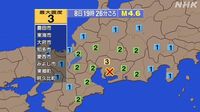On April 8, 2025, at 19:26, a noticeable earthquake struck western Aichi Prefecture, Japan, with a magnitude estimated at 4.6. According to the Japan Meteorological Agency, the epicenter was located at a depth of approximately 40 kilometers, specifically at coordinates 34.9 degrees North latitude and 137.1 degrees East longitude.
The tremor was felt across several cities and towns in Aichi Prefecture, where a seismic intensity of 3 was recorded. This included notable locations such as Toyota City, Tokai City, Oobu City, Chita City, Aisai City, Miyoshi City, Higashiura Town, and Agui Town. Residents in these areas experienced a moderate shaking, which is often enough to cause alarm but typically does not result in significant damage.
In addition to the areas experiencing seismic intensity of 3, other regions across Japan, including parts of Tokai, Hokuriku, Kinki, and Koshin, reported lower seismic intensities of 2 and 1. These readings indicate that while the earthquake was felt more strongly in Aichi, it was still perceptible in other regions, albeit to a lesser degree.
The Japan Meteorological Agency has reassured the public that there is no concern for a tsunami resulting from this earthquake. This announcement is crucial, as it alleviates fears that often accompany seismic events in coastal regions.
Earthquakes are a common occurrence in Japan, a nation situated on the Pacific Ring of Fire, where tectonic plate movements frequently lead to seismic activity. The country has rigorous building codes and emergency preparedness measures in place to mitigate the impacts of such natural disasters.
Despite the potential for significant earthquakes in Japan, the public response to this particular event has been measured. Many residents reported feeling the tremors but remained calm, a testament to the preparedness and resilience of the Japanese people in the face of natural disasters.
This earthquake serves as a reminder of Japan's ongoing battle with seismic activity. Authorities continue to monitor the situation closely, ensuring that residents are informed and prepared for any aftershocks or further seismic activity that may occur.
In conclusion, while the earthquake on April 8 was significant enough to be felt widely, the lack of tsunami risk and the relatively low seismic intensity in many areas suggest that the immediate threat to life and property was minimal. As Japan continues to navigate the challenges posed by its geological setting, the focus remains on safety, preparedness, and community resilience.






